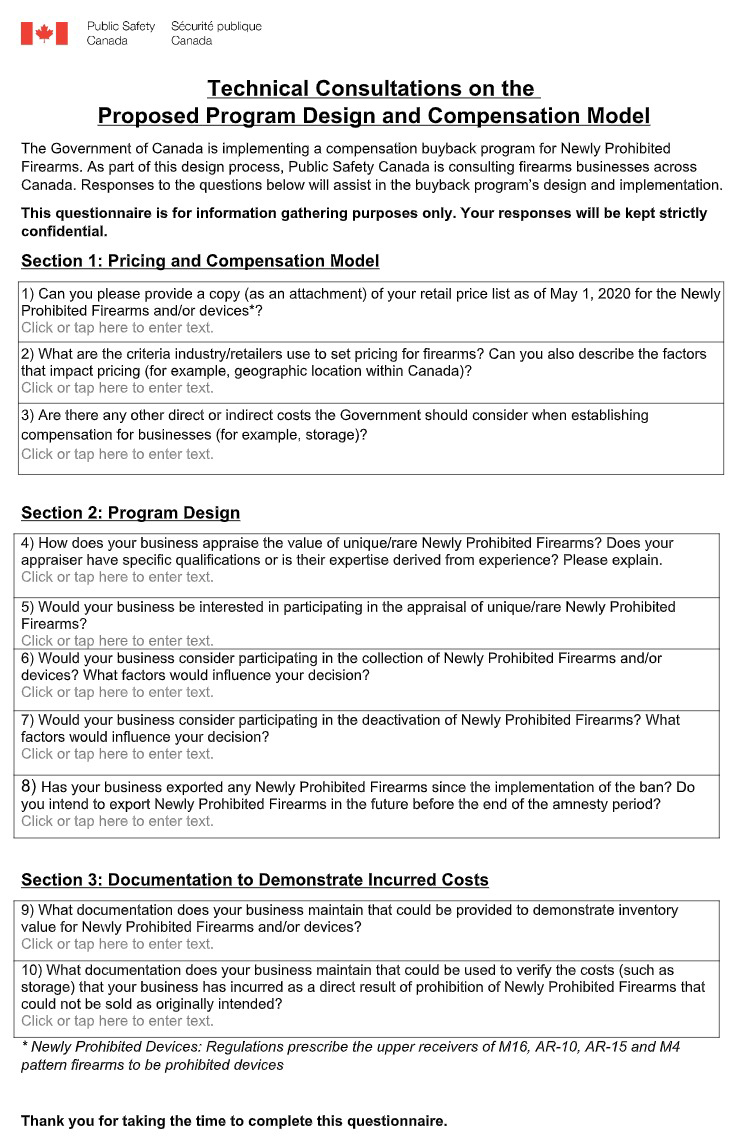
UPDATE: Provided Feb 14, 2022
Public Safety Canada has provided this update when asked for comment:
"The Government’s top priority is ensuring the safety and security of Canadians. We are committed to bringing forward a mandatory buyback program that offers fair compensation to affected owners and businesses while removing the now prohibited firearms from our communities. An Amnesty Order is in place to protect impacted individuals and businesses from criminal liability as they take steps to comply with the law. During the amnesty period, individuals can dispose of these now prohibited firearms through deactivation by an approved business, surrender to a police officer, export with a valid permit, and if a business, return to the manufacturer. Any individual who wants to surrender their firearm to police should always make arrangements with local law enforcement prior to surrendering their firearm.
Officials are currently in the process of refining requirements and developing options for program design and implementation. The purpose of the technical consultations is to help inform the proposed buyback program design and compensation model for firearm businesses and owners across Canada. Information obtained from these consultations will be compiled, reviewed, analyzed, and where applicable used to inform program design.
Further information on the design of the buyback program will be communicated to Canadians in due course."
ORIGINAL STORY:
A Public Safety Canada questionnaire sent to Canadian firearms industry members this morning seems to indicate the Trudeau government’s rifle ban continues to misfire.
The email, sent to Canadian gun industry members “sincerely apologize[s] for the delay in communicating the next steps,” and comes over a year after the consultations sought were initially solicited. Today, just over 11 weeks remain before the amnesty protecting licensed owners of the “Newly Prohibited Firearms” expires, and exposes hundreds of thousands of licensed gun owners to potential Criminal Code charges for possession of a prohibited firearm, or device.
The attached consultation questionnaire asks for such fundamental information as retail price lists, documentation to support the provided pricing, and any additional incurred costs associated with the newly prohibited firearms. At one point the consultation bluntly asks firearms industry members, “how does your business appraise the value of unique/rare Newly Prohibited Firearms? Does your appraiser have specific qualifications or is their expertise derived from experience? Please explain.”

That is a very fundamental question for a multi-billion dollar program to be asking 11 weeks before its proposed completion date, given a large percentage of the “Newly Prohibited Firearms” are unique or rare. Norinco M14 rifles, for example, are one of such firearm and regularly fetch prices exceeding $2,000 CDN on major auction sites. The Swiss Arms rifles prohibited cost three times that much or more. And even small, inane Canadian parts are valuably rare, with a bolt carrier group (a single part no larger than a flashlight) from a Colt Canada AR-15 valued at roughly $900 CDN.
The so-called “buy-back,” or compensation program being discussed by this consultation lies at the heart of the rifle ban passed by way of Order-in-Council (OIC) by Justin Trudeau and then-Safety Minister Bill Blair in May of 2020, in the days immediately following the mass murder of 22 people by arson and illegal firearms in Portapique earlier that year. Being passed by OIC, the ban wasn’t debated in the House of Commons nor researched by parliamentary or senate staff nor committee, and as such has been perennially hamstrung by imprecise wordings and legal issues that have seen the ban contested at the provincial and federal levels, with cases ongoing before numerous provincial courts and the Supreme Court of Canada.
Now, hundreds of thousands of owners of the millions of rifles banned in 2020 have awaited news for nearly two years, while the rifles in question have been required to be securely stored and locked, and cannot be used, transported, or sold. Industry members, many of whom may hold millions of dollars in newly prohibited inventory, have been forced to warehouse the firearms as most cannot be legally exported, incurring large overhead costs for secure storage as well as opportunity costs; tying up millions in capital through the worst of the pandemic.
Over that same period, shootings have risen sharply, with some jurisdictions reporting increases of over 50%. And most recently leadership within the law enforcement community has begun to speak out against proposed gun bans as ineffective, and a poor use of public safety funds. Recent reports from the CBSA indicate that the government (somewhat obviously) doesn’t know the volume of firearms smuggled across the longest undefended border in the world, shared with the planet’s most heavily armed nation. However, most recently, Toronto Police Deputy Chief Myron Demkiw said that of all crime firearms recovered that could be traced last year, 86% were found to have been illegally smuggled from the USA.
We have reached out to public safety, but have not received comment as yet.